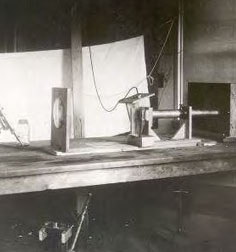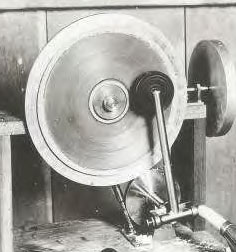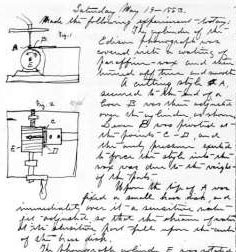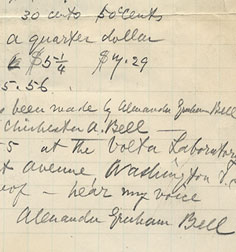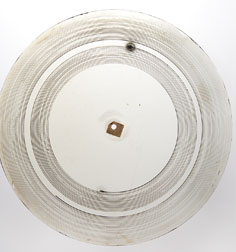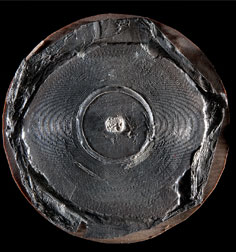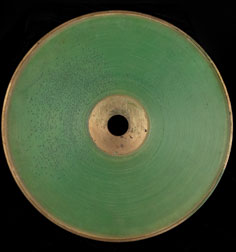
Sound Experiments at the Volta Laboratory
Alexander Graham Bell, Charles Sumner Tainter, and Chichester Bell—collectively the Volta Laboratory Associates—conducted a wide range of sound experiments. Improving Thomas Edison’s phonograph and phonograph record were their major goals.
They researched various techniques to record and play back sound, including photography and magnetic reproduction. They built machines for both cylinder and disc records and even a kind of recorder for use with waxed paper tape. They sought a durable recording medium and investigated materials of all sorts, alone and in combinations. And they explored methods to produce multiple copies of a single recording.
Their experiments led to commercial innovations—most notably the wax cylinder record and the graphophone, a machine to record and play back cylinders.
Experiment in the Volta Laboratory, 1884. This photograph, taken inside the laboratory, shows the apparatus of an experiment to record sound photographically. A man’s hand, rotating a glass plate mounted on a lathe, is visible at right.
Notebook belonging to Charles Sumner Tainter, describing sound experiments at the Volta Laboratory (Gift of Laura Fontaine Onderdonk Tainter)
The Volta Associates experimented with recordings on both cylinders and discs. Ultimately, Emile Berliner, also working in Washington, D.C., in the 1880s, would successfully commercialize the disc record, develop a way to mass-produce it, and devise a machine to play it: the gramophone.
These are some of the earliest surviving sound recordings. They were made at the Volta Laboratory, most likely in 1884 and 1885.
The experimenters—Alexander Graham Bell, Chichester Bell, and Charles Sumner Tainter—imagined their invention would mainly serve as a business machine, for taking dictation or recording telephone conversations. So their goal was to find the best combination of materials and methods to record clear speech.
Below is pictured an experimental wax disc that contains the only confirmed recording of the voice of Alexander Graham Bell. He made it in 1885 to test with what clarity the recording could capture spoken numbers. On the recording, after several minutes of counting, Bell concludes:
“This record has been made by Alexander Graham Bell in the presence of Dr. Chichester A. Bell—on the fifteenth of April, 1885, at the Volta Laboratory, 1221 Connecticut Ave., Washington, D.C. In witness whereof—hear my voice. Alexander Graham Bell.”
Transcription of sound recording in Alexander Graham Bell’s handwriting (Gift of Alexander Graham Bell)
The individual speakers on these recordings are unidentified. Sometimes they quote Shakespeare, other times they count or repeat just a single word to test how clearly the word could be recorded. They frequently utter a trilled letter r, which made a very distinct sound. Only one of these sound recordings was of music.
Sound recording, glass disc with photographic emulsion, made March 11, 1885 (Gift of Alexander Graham Bell)
Speaker: unknown
Content: “. . . and H. G. Rogers. It’s the eleventh day of March, 1885 [trilled r sound]. Who pushed in the pipe? Mary had a little lamb and its fleece was white as snow . . . . Everywhere that Mary went . . . [startled noise] [tone]. Mary had a little lamb and its fleece was white as snow. Everywhere that Mary went, the little lamb was sure to go. How is this for high? . . .”
Experiment goals:
• show how to record sound with a photographic process
Sound recording, cardboard disc with layers of plaster and foil, made about 1885 (Gift of Alexander Graham Bell)
Speaker: unknown
Content: “. . . I am a magnetical graphophone. What are you? . . .” (partial copy of recording made in 1881)
Experiment goals:
• demonstrate method and materials for copying recordings
Speaker: unknown
Content: “To be, or not to be: that is the question. Whether it is nobler in the mind to suffer the slings and arrows of outrageous fortune, or to take arms against a sea of troubles, and in opposing end them? To die: to sleep.”
Experiment goals:
• show effects of dye on qualities of wax
Sound recording, glass disc with photographic emulsion, made November 17, 1885 (Gift of Alexander Graham Bell)
Speaker: unknown
Content: “ba-ro-me-ter.”
Experiment goals:
• show how to record sound with a photographic process
Speaker: unknown
Content: musical selections “Killarney” and “Hot-Shot March.”
Experiment goals:
• demonstrate how clearly music could be recorded

